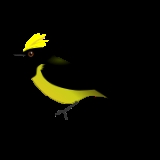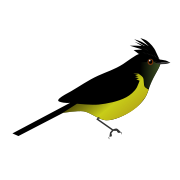
Sultan Tit
Encyclopedia
The Sultan Tit is a large songbird
(about 17 cm long) with a yellow crest, dark bill
, black upperparts plumage and yellow underparts. The sexes are similar. The female has greenish black upperparts and yellowish throat. The young bird is duller than the adult and has a shorter crest.
It is the only member of the monotypic
genus
Melanochlora, which is fairly distinct from the Parus tits with the nearest relative being the monotypic Sylviparus.
 The male has the forehead and crown with the crest brilliant yellow; the whole upper plumage, sides of the head and neck, chin, throat, and breast deep black glossed with green, the edges of the feathers of the upper plumage with a metallic lustre, and the outermost tail-feathers tipped with white; lower plumage from the breast downwards deep yellow, the thighs barred or mottled with white. The recumbent crest is raised when the bird is alert or alarmed.
The male has the forehead and crown with the crest brilliant yellow; the whole upper plumage, sides of the head and neck, chin, throat, and breast deep black glossed with green, the edges of the feathers of the upper plumage with a metallic lustre, and the outermost tail-feathers tipped with white; lower plumage from the breast downwards deep yellow, the thighs barred or mottled with white. The recumbent crest is raised when the bird is alert or alarmed.
The female has the yellow parts duller; the upper plumage and sides of the head dark greenish brown; the chin and throat glossed dark olive-green; wings and tail dull black; the feathers of the upper plumage edged with metallic green.
The young resemble the female, but in the youngest stage the bright edges to the plumage of the upper parts are absent, and the greater wing-coverts are edged with white.
They forage in the mid and upper canopy singly or in small groups mainly and feed mainly on insects but sometimes feed on figs. Their loud calls with short repeated and variable whistling notes have a tit-like quality. The flight is slow and fluttery.
The bill is black; the mouth dark fleshy; the eyelids grey; the iris dark brown; the legs are grey; the claws dark horn. The length is about 8 inches; the tail measures 3.8 inches; the wing 4.4 inches; the tarsus 0.95 inches; the bill from the gape 0.75 inches.
considered this species as a member of the former subfamily Liotrichinae within the Timaliidae. The position of this species within its clade is still not clearly established. They appear to have distinctive mtDNA cytochrome b
sequences
, suggesting that they might not belong to the Paridae unless the penduline tit
s are included. They show an unusual behaviour of panicking in captivity when they encounter unusual noise or other species which has been said to be unlike that of typical Paridae members. Unlike typical Paridae, they have their nostrils exposed and not covered by feathers. If it is considered a member of the Paridae, it would be the largest member.
In India, this species occurs in the lower ranges of the Himalayas
from Nepal to the head of the Assam valley,the Khasi hills, Cachar, Manipur, the Kakhyen hills east of Bhamo, Arrakan, the Pegu hills, Karennee, and Tenasserim. This species does not appear to be found above 4000 feet of elevation. It extends down the Malay peninsula. It frequents the larger trees in small flocks. In some forest areas such as the Buxa Tiger Reserve
, the density has been estimated at around 15 per square kilometre.
The breeding season in India is April to July and the clutch is of seven eggs laid inside a lined tree cavity. They feed on caterpillars and sometimes small berries.
Widely distributed within suitable habitats throughout its large range, the Sultan Tit is evaluated as Least Concern on the IUCN Red List
of Threatened Species.
Songbird
A songbird is a bird belonging to the suborder Passeri of the perching birds . Another name that is sometimes seen as scientific or vernacular name is Oscines, from Latin oscen, "a songbird"...
(about 17 cm long) with a yellow crest, dark bill
Beak
The beak, bill or rostrum is an external anatomical structure of birds which is used for eating and for grooming, manipulating objects, killing prey, fighting, probing for food, courtship and feeding young...
, black upperparts plumage and yellow underparts. The sexes are similar. The female has greenish black upperparts and yellowish throat. The young bird is duller than the adult and has a shorter crest.
It is the only member of the monotypic
Monotypic
In biology, a monotypic taxon is a taxonomic group with only one biological type. The term's usage differs slightly between botany and zoology. The term monotypic has a separate use in conservation biology, monotypic habitat, regarding species habitat conversion eliminating biodiversity and...
genus
Genus
In biology, a genus is a low-level taxonomic rank used in the biological classification of living and fossil organisms, which is an example of definition by genus and differentia...
Melanochlora, which is fairly distinct from the Parus tits with the nearest relative being the monotypic Sylviparus.
Description

The female has the yellow parts duller; the upper plumage and sides of the head dark greenish brown; the chin and throat glossed dark olive-green; wings and tail dull black; the feathers of the upper plumage edged with metallic green.
The young resemble the female, but in the youngest stage the bright edges to the plumage of the upper parts are absent, and the greater wing-coverts are edged with white.
They forage in the mid and upper canopy singly or in small groups mainly and feed mainly on insects but sometimes feed on figs. Their loud calls with short repeated and variable whistling notes have a tit-like quality. The flight is slow and fluttery.
The bill is black; the mouth dark fleshy; the eyelids grey; the iris dark brown; the legs are grey; the claws dark horn. The length is about 8 inches; the tail measures 3.8 inches; the wing 4.4 inches; the tarsus 0.95 inches; the bill from the gape 0.75 inches.
Taxonomy and systematics
In 1890, Richard Bowdler SharpeRichard Bowdler Sharpe
Richard Bowdler Sharpe was an English zoologist.-Biography:Sharpe was born in London and studied at Brighton College, The King's School, Peterborough and Loughborough Grammar School. At the age of sixteen he went to work for Smith & Sons in London...
considered this species as a member of the former subfamily Liotrichinae within the Timaliidae. The position of this species within its clade is still not clearly established. They appear to have distinctive mtDNA cytochrome b
Cytochrome b
Cytochrome b/b6 is the main subunit of transmembrane cytochrome bc1 and b6f complexes. In addition, it commonly refers to a region of mtDNA used for population genetics and phylogenetics.- Function :...
sequences
DNA sequence
The sequence or primary structure of a nucleic acid is the composition of atoms that make up the nucleic acid and the chemical bonds that bond those atoms. Because nucleic acids, such as DNA and RNA, are unbranched polymers, this specification is equivalent to specifying the sequence of...
, suggesting that they might not belong to the Paridae unless the penduline tit
Penduline tit
The penduline tits are a family of small passerine birds, related to the true tits. All but the Verdin and Fire-capped Tit make elaborate bag nests hanging from trees , usually over water; inclusion of the Fire-capped Tit in this family is disputed by some authorities.-Characteristics:Penduline...
s are included. They show an unusual behaviour of panicking in captivity when they encounter unusual noise or other species which has been said to be unlike that of typical Paridae members. Unlike typical Paridae, they have their nostrils exposed and not covered by feathers. If it is considered a member of the Paridae, it would be the largest member.
Distribution
Four subspecies are recognized with the nominate sultanea (Hodgson, 1837) found from Central Nepal into the eastern Himalayas extending into Myanmar, northern Thailand and Southern China. This intergrades with the race flavocristata (Lafresnaye, 1837) is found further south in Thailand, the Malay Peninsula and Hainan. Race seorsa is found in Laos and parts of southeastern China (Guangxi, Fujian) and in its northern range intergrades with sultanea. Race gayeti Delacour & Jabouille, 1925 which has a black crest in both males and females is found in Laos and Vietnam.In India, this species occurs in the lower ranges of the Himalayas
Himalayas
The Himalaya Range or Himalaya Mountains Sanskrit: Devanagari: हिमालय, literally "abode of snow"), usually called the Himalayas or Himalaya for short, is a mountain range in Asia, separating the Indian subcontinent from the Tibetan Plateau...
from Nepal to the head of the Assam valley,the Khasi hills, Cachar, Manipur, the Kakhyen hills east of Bhamo, Arrakan, the Pegu hills, Karennee, and Tenasserim. This species does not appear to be found above 4000 feet of elevation. It extends down the Malay peninsula. It frequents the larger trees in small flocks. In some forest areas such as the Buxa Tiger Reserve
Buxa Tiger Reserve
The Buxa National Park is a national park located in West Bengal, India, in the Buxa hills of the southern hilly area of Bhutan. Located inside the national park is the 760 km² Buxa Tiger Reserve. Animals found in the park include, the tiger, civet and red jungle fowl.-Location:Buxa Tiger...
, the density has been estimated at around 15 per square kilometre.
The breeding season in India is April to July and the clutch is of seven eggs laid inside a lined tree cavity. They feed on caterpillars and sometimes small berries.
Widely distributed within suitable habitats throughout its large range, the Sultan Tit is evaluated as Least Concern on the IUCN Red List
IUCN Red List
The IUCN Red List of Threatened Species , founded in 1963, is the world's most comprehensive inventory of the global conservation status of biological species. The International Union for Conservation of Nature is the world's main authority on the conservation status of species...
of Threatened Species.
Other sources
- Del Hoyo, J.; Elliot, A. & Christie D. (editors). (2007). Handbook of the Birds of the WorldHandbook of the Birds of the WorldThe Handbook of the Birds of the World is a multi-volume series produced by the Spanish publishing house Lynx Edicions. It is the first handbook to cover every known living species of bird. The series is edited by Josep del Hoyo, Andrew Elliott, Jordi Sargatal and David A Christie.So far, 15...
. Volume 12: Picathartes to Tits and Chickadees. Lynx Edicions. ISBN 9788496553422

